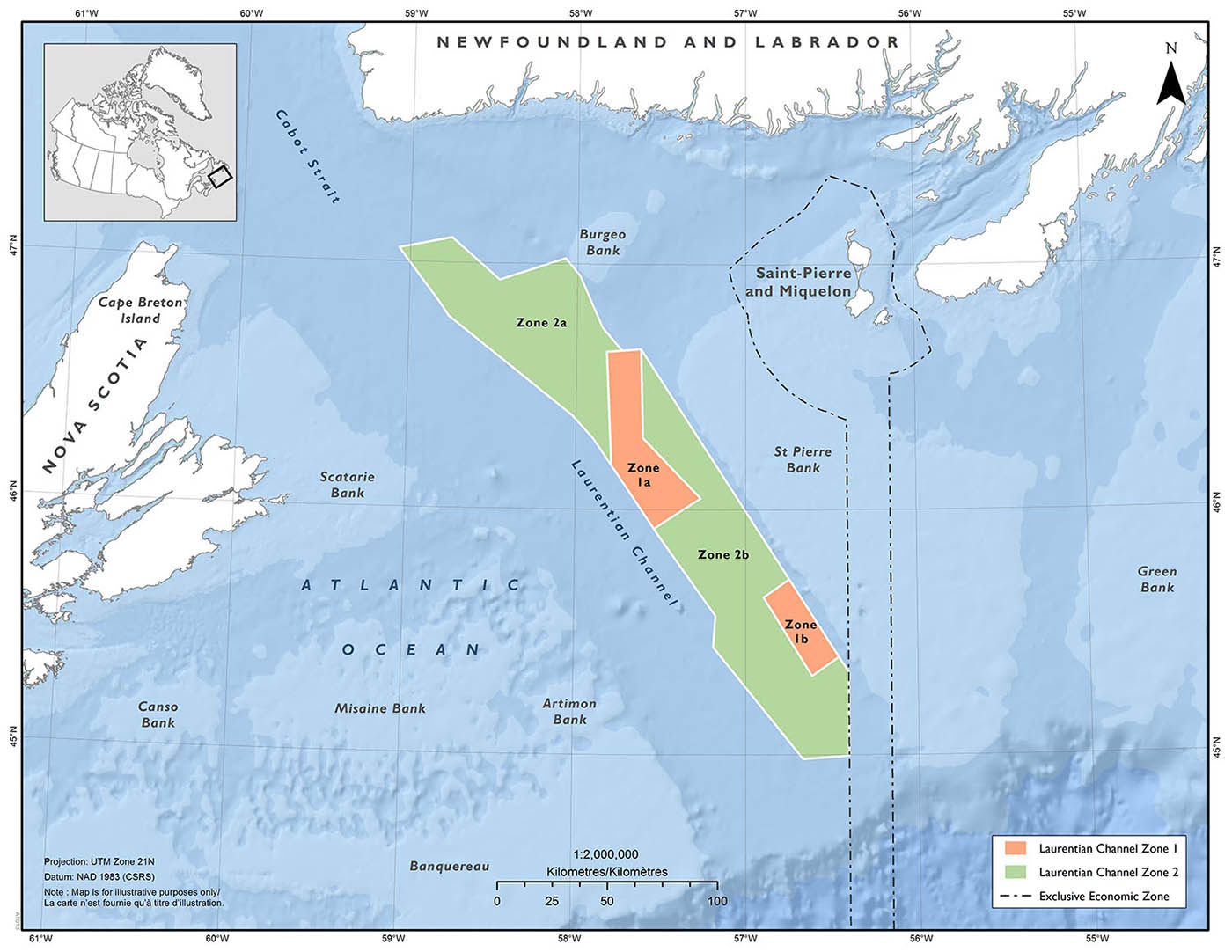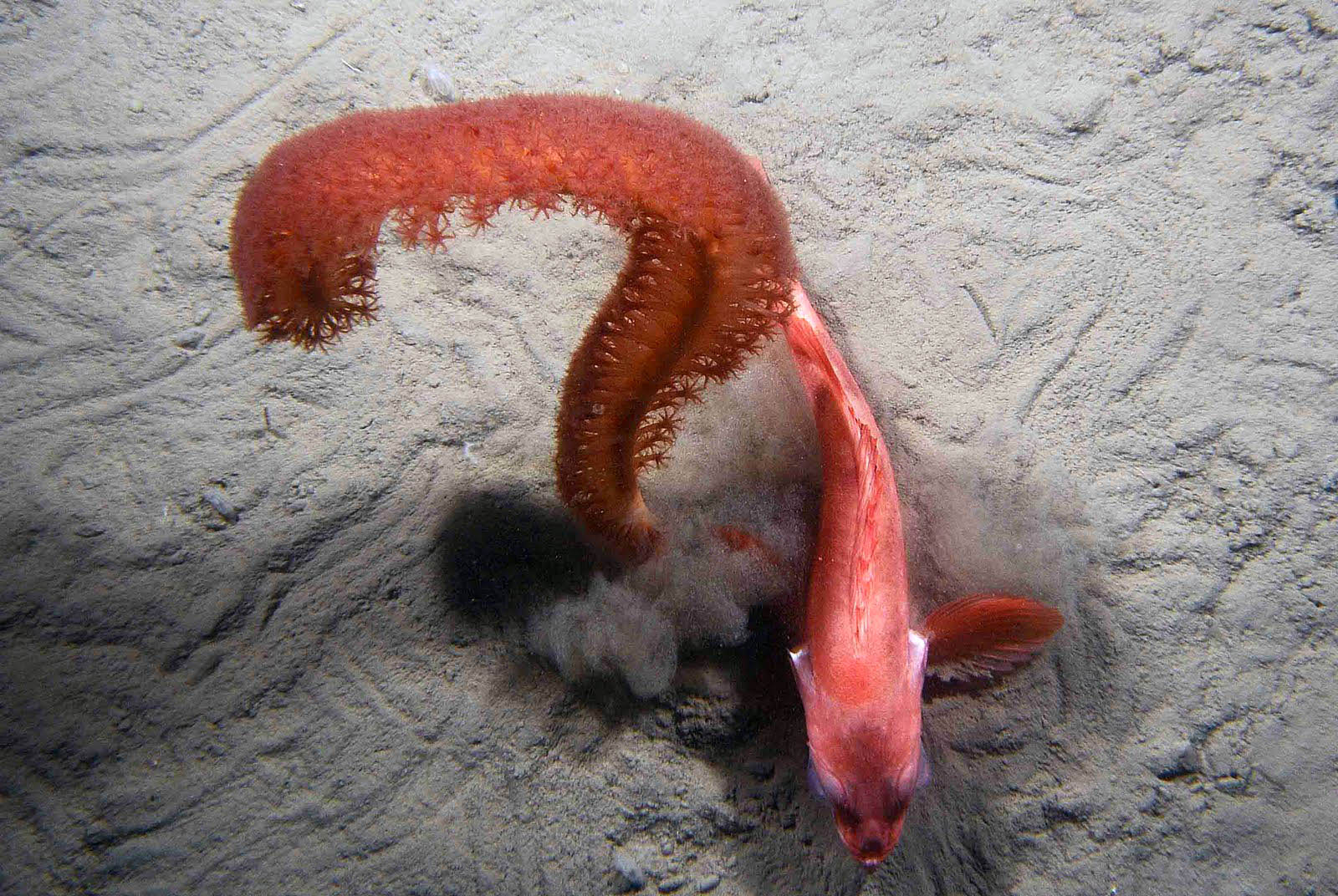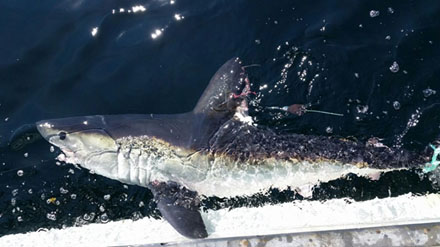Laurentian Channel Marine Protected Area (MPA)
Note:
Charts, diagrams and contact information on this website are provided for information purposes only and should not be used for fishing, navigation or other purposes. Please refer to the MPA Regulations or contact your regional Fisheries and Oceans Canada office for official coordinates.
At-A-Glance
At-A-Glance

Map: Laurentian Channel Marine Protected Area (MPA)
Dataset for all MPAs available.

Sea pen with redfish © DFO
Location
Off the southwest coast of Newfoundland and Labrador; Newfoundland and Labrador Shelves Bioregion.
Approximate Size (km²) contribution to Marine Conservation Targets
11,580 km²
Approximate % coverage contribution to Marine Conservation Targets
0.20%
Date of Designation
April 2019
Conservation Objectives
- Protect corals, particularly significant concentrations of sea pens, from harm due to human activities (e.g., fishing, oil and gas exploratory drilling, submarine cable installation and anchoring) in the Laurentian Channel.
- Protect Black Dogfish from human induced mortality (e.g., bycatch in the commercial fishery) in the Laurentian Channel.
- Protect Smooth Skate from human induced mortality (e.g., bycatch in the commercial fishery) in the Laurentian Channel.
- Protect Porbeagle sharks from human induced mortality (e.g., bycatch in the commercial fishery, seismic activities) in the Laurentian Channel.
- Promote the survival and recovery of Northern Wolffish by minimizing risk of harm from human activities (e.g., bycatch in the commercial fishery) in the Laurentian Channel.
- Promote the survival and recovery of Leatherback Sea Turtles by minimizing risk of harm from human activities (e.g., entanglement in commercial fishing gear, seismic activities) in the Laurentian Channel.
Prohibitions
Laurentian Channel MPA Regulations prohibit activities that disturb, damage, destroy or remove from this Area, living marine organisms or any part of their habitat or that is likely to do so, unless listed as exceptions in the Regulations or approved by the Minister. Recreational and commercial fishing, and oil and gas exploration and exploitation are prohibited in all zones of the MPA. The Core Protection Zone provides additional protection by prohibiting anchoring and laying of submarine cables.
Environmental Context
The Laurentian Channel is a deep submarine valley more than 1,200 km in length, stretching from the intersection of the St. Lawrence and Saguenay Rivers to the edge of the continental shelf off Newfoundland. The area of the entire Channel is approximately 35,800 km²; however, the MPA occupies only 11,580 km² of the total. The MPA includes the seabed, the subsoil to a depth of five metres, and the water column above the seabed.
The Laurentian Channel MPA provides important habitat for a variety of marine species. Black dogfish and juvenile smooth skate are present in high numbers throughout the area. Porbeagle and basking sharks move into the area in the spring and reside within the MPA throughout the summer, and one of only two known porbeagle mating grounds occurs within the MPA boundaries. Two species at risk, the Northern wolffish and the leatherback sea turtle, have been found in the area. At least 20 species of whales and dolphins have also been observed in the area, as it is a critical feeding area and migration route into and out of the Gulf of St. Lawrence. In addition, the Laurentian Channel MPA has been described as having the highest sea-pen concentrations in the entire Newfoundland and Labrador Shelves bioregion.
Ecosystem
Ecosystem

A Satellite tagged Porbeagle shark being released © DFO

Juvenile and adult sea pen colonies, solitary stony corals, sea anemone and fish in the Laurentian Channel MPA © CHONe-CSSF-DFO
The Laurentian Channel is a deep submarine valley over 1,200 km long, which extends from where the St. Lawrence Estuary and Saguenay River meet to the edge of the continental shelf off Newfoundland. The depth of the MPA varies from 100 to 500 m, with the basin of the Laurentian Channel being the deepest. In general, mud and clay characterize deeper areas and sand and gravel occur mainly on the banks. The majority of the Laurentian Channel MPA is deeper than 150 m. The northeast side of the MPA is the shallowest area, delimited by the edges of the Burgeo and St. Pierre Banks.
The Laurentian Channel MPA will support the conservation of a wide range of habitats and marine species, including commercially important and at risk species, and areas with high concentrations of sensitive seafloor corals called sea pens. The complex circulation and oceanographic conditions in the Laurentian Channel MPA result in a unique habitat. The area is an important spawning, nursing, and feeding area for a variety of species.
The Laurentian Channel MPA is an ecologically important area, providing important habitat for a variety of marine species. Black Dogfish and juvenile Smooth Skate are present in high numbers throughout the area. Porbeagle and basking sharks move into the area in the spring and reside within the MPA throughout the summer. One of only two known Porbeagle mating grounds occurs within the boundaries. Two species at risk, the Northern wolffish and the leatherback sea turtle, have been found in the area. In addition, at least 20 species of whales and dolphins have been observed in the area, as it is a critical feeding area and migration route into and out of the Gulf of St. Lawrence.
The Laurentian Channel contains significant coral concentrations, in particular sea pen populations, representing sensitive benthic habitats. Corals are important to the ecosystem and depend on the integrity of the sands and muds in the area for their survival. Of the variety of coral species found in the area, sea pens have been recorded in the greatest numbers and diversity, with the Laurentian Channel being described as having the highest sea pen concentrations within the entire Newfoundland and Labrador Shelves Bioregion.
Management and Conservation
Management and Conservation
The primary objective of the Laurentian Channel MPA is to conserve biodiversity through the protection of key species and their habitats, ecosystem structure and function, and through scientific research. The most effective way to preserve biodiversity and ensure the survival of species is through long-term habitat protection. The MPA regulations foster biodiversity conservation in the Laurentian Channel through the reduction of risk and harm posed by human activities.
A Management Plan for the Laurentian Channel MPA is under development. The management plan will outline DFO's approach to managing activities in the MPA. The plan will provide further guidance on the Regulations and a comprehensive set of conservation and management strategies for the MPA.
The Regulations prohibit any activity that disturbs, damages, destroys or removes a living marine organism or any part of its habitat in the Laurentian Channel MPA. This includes a prohibition on recreational and commercial fishing, oil and gas exploration and exploitation throughout the MPA.
The Regulations allow certain exceptions to the prohibitions for specified activities, if they are compatible with the conservation objectives of the MPA, these include:
- Aboriginal food, social and ceremonial fisheries;
- Marine Navigation;
- Installation, repair and maintenance of submarine cables continue to be allowed in Zones 2a and 2b as long as they are not likely to destroy marine habitat;
- Scientific research, scientific monitoring, and educational activities are allowed throughout the MPA, subject to the Minister's approval of an activity plan; and
- Activities related to safety and security.
As the lead federal authority for the MPA, DFO has overall responsibility for ensuring compliance with, and enforcement of the Regulations. This is undertaken through the Department's legislated mandate and responsibilities under the Oceans Act and the Fisheries Act, as well as other legislation applicable to fisheries conservation, environmental protection, habitat protection and marine safety. Enforcement officers designated by the Minister pursuant to section 39 of the Oceans Act will enforce the Regulations for these areas. Anyone contravening the Regulations commits an offence and can be subject to the punishments listed in section 37 of the Oceans Act.
Activity Application
Activity application for Laurentian Channel MPA
Activities focused on scientific research or monitoring or education are allowed to take place in the Laurentian Channel MPA, if the proponent submits an activity plan to Fisheries and Oceans Canada and receives approval from the Minister.
Research and Publications
Research Objectives
- Advance the understanding of the location, health and integrity of cold water corals and sponges in the Laurentian Channel MPA.
- Identify important as well as sensitive marine benthic areas and habitats in the Laurentian Channel MPA by supporting the conduct of scientific surveys, mapping and habitat association studies.
- Advance the understanding of plankton variability in the area and locations of enhanced productivity supporting benthos, fish and cetaceans.
- Advance the understanding of cetacean distribution, abundance and migration in the Laurentian Channel MPA.
- Advance the understanding of the spatial and temporal distribution of sharks and potential threats to sharks in the Laurentian Channel MPA.
- Advance scientific studies contributing to the identification and understanding of significant or critical habitat for SARA listed species found in the Laurentian Channel MPA.
Publications
- Laurentian Channel Marine Protected Area (MPA) annual report 2023
- A Framework for the Identification of Monitoring Indicators Protocols and Strategies for the Proposed Laurentian Channel Marine Protected Area (MPA) (CSAS ResDocs - 2014/093)
- Biophysical Overview of the Laurentian Channel Area of Interest (AOI) (2011) (CSAS SAR - 2010/076)
- Distribution and habitat associations of selected demersal fish species in the Laurentian Channel and Laurentian Area of Interest (AOI) (2013) (CSAS ResDocs - 2013/099)
- Laurentian Channel News Release (2017)
- Monitoring Indicators, Protocols and Strategies for the Proposed Laurentian Channel Marine Protected Area (MPA) (CSAS SAR - 2014/049)
- Placentia Bay-Grand Banks Large Ocean Management Area science-based conservation objectives (2007) (PDF)
- Date modified: